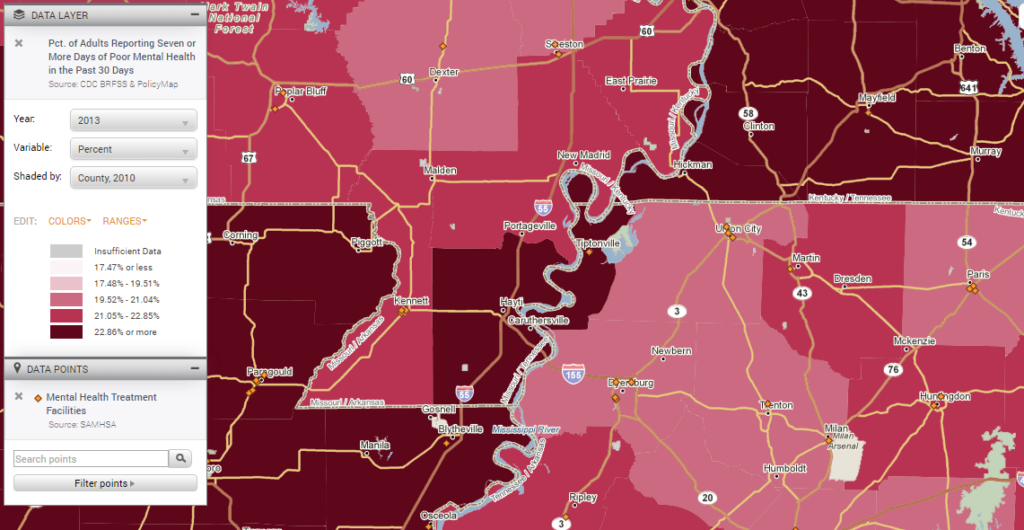Mental Health and Substance Abuse Treatment Facilities Now on PolicyMap

Several weeks ago, I had the opportunity to attend the National Association of City and County Health Officials (NACCHO) conference in Kansas City, MO. It was a great chance to connect with local health departments from around the country and learn about current trends and challenges in the field. Among the many topics that came up throughout the conference, in sessions ranging from the opioid epidemic to community policing, was that of local public health responses to our communities’ growing mental illness and substance abuse needs.
According to NACCHO, mental disorders are the leading cause of disability in the US for ages 15-44, and they account for more than 15 percent of the overall burden of disease in the United — more than the disease burden of all cancers combined. Mental illness is often a co-occurring condition for adults with chronic disease such as diabetes, hypertension, and obesity. Mental illness is also linked very closely with substance abuse; in fact, studies show that around two-thirds of people who have a substance abuse condition also have a mental health condition.
Given the prominence of these topics in public health discussions, it is not surprising that we have been receiving a growing number of requests for mental health and substance abuse data on PolicyMap. In response to this demand, we are excited to announce that we now have the locations of mental health treatment facilities and substance abuse treatment facilities available for free. These data are from the Substance Abuse and Mental Health Services Administration’s (SAMHSA) treatment services locator, and you can find them under the Health tab.
The map below shows mental health treatment facilities layered over the percent of adults reporting 7 or more days of poor mental health in the past 30 days, one of the new neighborhood level health indicators we recently added from the Behavior Risk Factor Surveillance System (BRFSS). You can see that in Pemiscot, Missouri, one of the worst ranked counties in Missouri for health outcomes according to the County Health Rankings & Roadmaps, there are no mental health treatment facilities despite a high percentage of residents reporting poor mental health.
There are few drugs making more local and national headlines than opioids (a group of drugs that includes prescription drugs and heroin): the Center for Disease Control and Prevention has classified opioid abuse as an epidemic. Indeed, prescription drug and heroin addictions are interdependent problems. A recent study by SAMHSA found that four out of five heroin users had previously taken a prescription pain reliever for non-medical use. Many people addicted to prescription pain relievers have found those medicines increasingly harder to get and have thus turned to heroin, which costs less and may be obtained more easily than opioids.
Treating opioid addiction is not easy. For example, methadone treatment (historically used for heroin addiction but now heavily used for the treatment of noncancer pain) has become controversial because it is seen as highly addictive and is associated with a high rate of overdose deaths. Using the new drug and alcohol treatment facilities data on PolicyMap, you can filter by Type of Care and see clinics that provide methadone maintenance therapy versus other types of treatment for opioid addiction:
When it comes to mental health disorders and substance abuse addictions, access to treatment is just one part of a complicated puzzle. There are a number of other factors, such as cultural/linguistic barriers, associated stigmas, and financial barriers, that contribute to whether patients get the treatment they need.
We hope you find these new health datasets helpful to your work. If there are other datasets you would like to see on PolicyMap, please let us know!